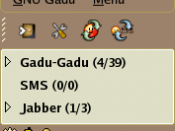Linguistic Features in Synchronous Internet Communication
Ho Hiu To, Hugo
Li Yin Yung Charmaine
Au Yeung Kam Mui, Mable
Chan Tze Ying, Karen
Lau So Fong, Sophie
Submitted to: Dr. Judy Ho
ENG 202
March 15, 2010
STUDENT NO: 1191557, 1104944
MAJOR: BACEE
YEAR: 2
Abstract
Instant Messaging (IM) is becoming an increasingly popular channel of synchronous internet communication especially among teenagers (Huang, 2008; Berglund, 2009; Crystal, 2006, p.248). The manifestations of IM clients such as ICQ, MSN, Facebook chat, has given rise to a unique structure of language communication in the internet community -Computer-mediated communication (CMC) (Crystal, 2006). It is of interest to see how participants of these electronic chat conversations can understand each other, considering that they are so unintelligible and different from face-to-face communication (Holmer, 2008). This paper examines the distinctive linguistic features in CMC texts that are extracted from Windows Live Messenger (WLM). Based on an approximately 800-word corpus of instant messages, collected from an undergraduate student whose first language is Cantonese and second language is English, this study investigates three most prevalent linguistic features in synchronous CMC and justifies their existence in accordance to the Hong Kong context.
TABLE OF CONTENTS
Page.No
INTRODUCTION
DATA COLLECTION
RESULTS & ANALYSIS
SHORTENINGS
3.11 Phonological Shortenings
3.12 Lexical Shortenings
3.13 Syntactic Shortenings
TRANSLITERATIONS
3.21 Romanized Cantonese Sentence Particles
3.22 Romanized Cantonese Expressions
3.3 EMOTICONS
4 CONCLUSIONS
5 REFERENCES
1. Introduction
Prior to the 96s, language communication was a laborious and deliberate process, considering one's options to communicate long distances were limited to telephones, letters and emails. With the introduction of online bulletins and discussion boards in the mid nineties, many computer technology corporations then recognized the importance of online discussion. Hence, Microsoft, created an instant messenger client named Windows Live messenger (WLM). This client enables synchronous internet chat...


